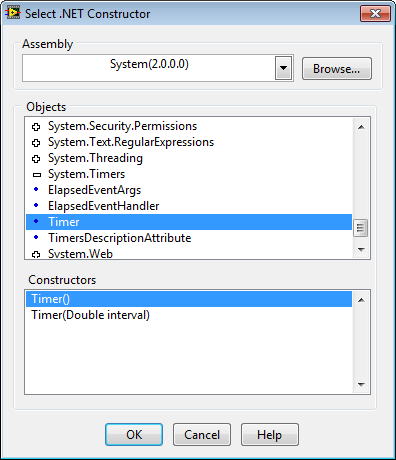- Document History
- Subscribe to RSS Feed
- Mark as New
- Mark as Read
- Bookmark
- Subscribe
- Printer Friendly Page
- Report to a Moderator
- Subscribe to RSS Feed
- Mark as New
- Mark as Read
- Bookmark
- Subscribe
- Printer Friendly Page
- Report to a Moderator
Instantiating .NET Objects from LabVIEW
» Calling External Code » .NET Assemblies » Instantiating .NET Objects
Instantiating .NET Objects from LabVIEW
The .NET Constructor Node (Functions Palette » Connectivity » .NET » Constructor Node) allows you to specify the class that you want to instantiate and its owning assembly. You can pick from the available constructors of the class, and the node will give you a reference to the .NET object. This reference can be wired to .NET Property Nodes and .NET Invoke Nodes to access properties and methods of the class.
For example, to create an instance of System.Timers.Timer, you would:
- Switch to the Block Diagram
- Drop in a Constructor Node (Functions Palette » Connectivity » .NET » Constructor Node)
- This will bring up the Select .NET Constructor dialog
Note: You can bring this dialog up in the future by double clicking on the Constructor Node. - Select the assembly System from the Assembly dropdown box
- In the Objects list, expand System.Timers and select the class Timer

Destroying .NET Objects from LabVIEW
When you are done using a .NET Object, you should destroy it to free up any resources associated with the object. To destroy a .NET object, wire in the object reference to the Close Reference VI (Functions Palette » Connectivity » .NET).

Examples & References
The following examples install with LabVIEW:
Calculator VI: labview\examples\comm\dotnet\Calculator.llb
SimpleTaskMonitor VI: labview\examples\comm\dotnet\SimpleTaskMonitor.llb
Community Example: Calling .NET Assemblies from LabVIEW
NI TestStand Product Manager
